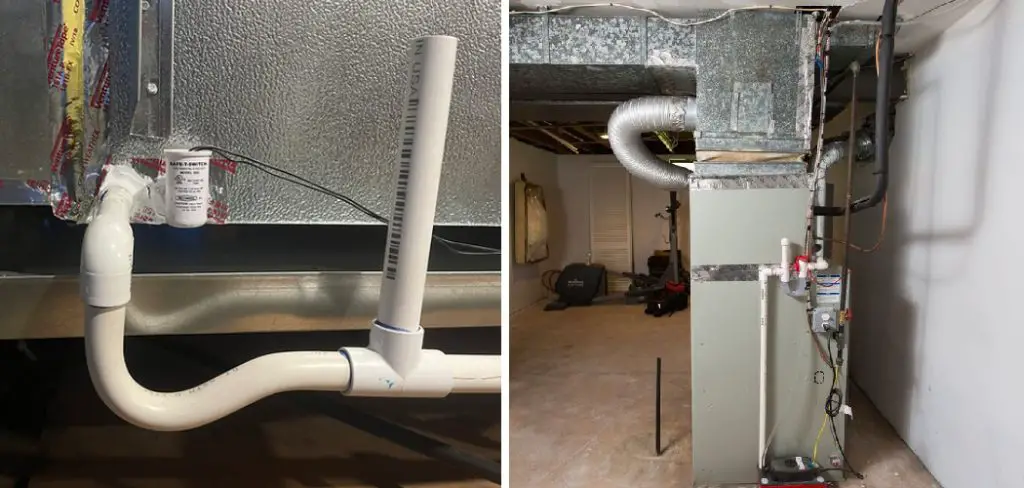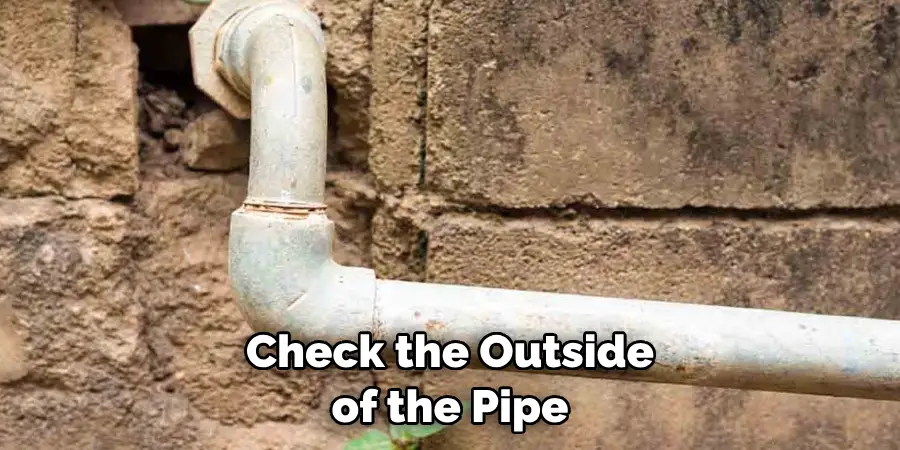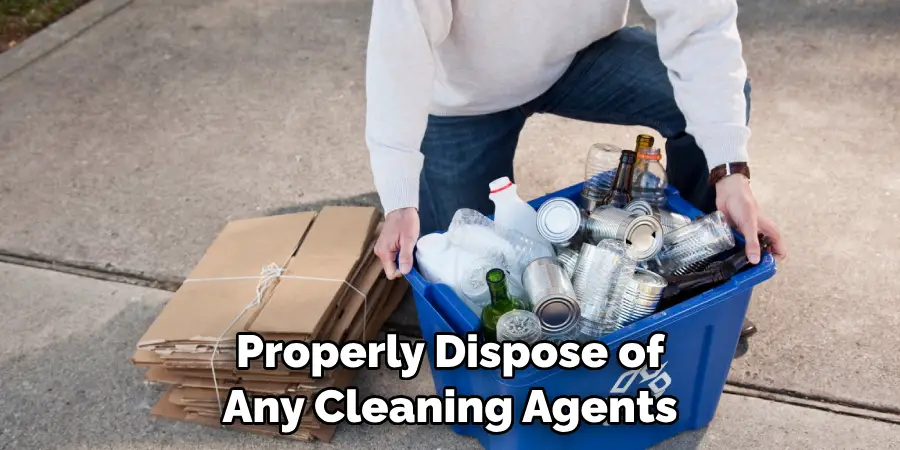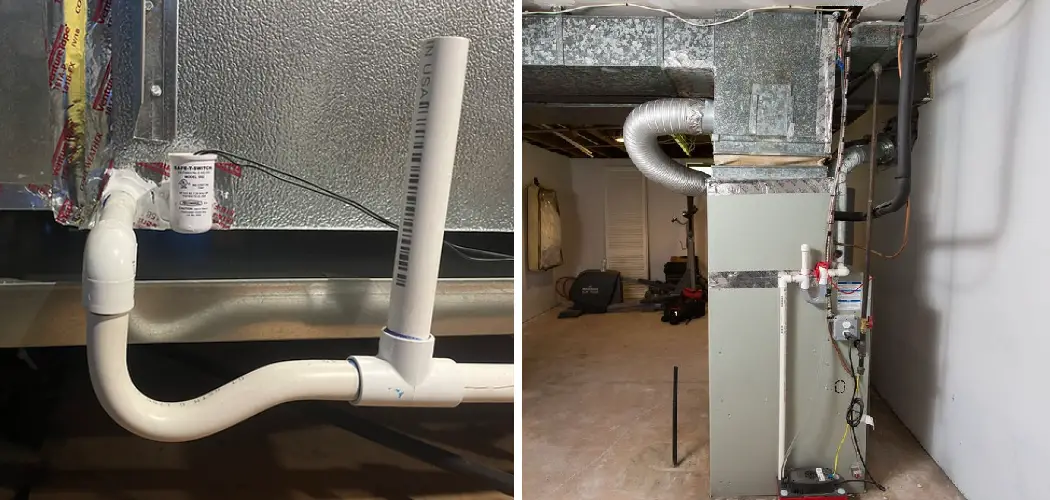Are you a homeowner trying to figure out how to clean your furnace condensate drain line? If so, you’re in the right place! Keeping your home warm in the winter means not only checking the filters and turning up the thermostat but also regularly cleaning out your furnace condensate drain line.
Regular maintenance of your furnace is important for its optimal performance and longevity, and one of the most essential components to keep an eye on is your condensate drain line.

In this blog post, we will discuss how often the line should be cleaned and what measures can be taken for safely cleaning it. Keep reading if you want to learn more about maintaining the proper functionality of this key component of the heating system in your home!
We’ll walk you through everything that you need to know about how to clean furnace condensate drain lines: what they are, why they need maintenance and step-by-step instructions on to safely tackle the task yourself!
Required Items
- A bucket or trash can for collecting water
- Waterproof work gloves
- Rags or paper towels for wiping up spills
- A vacuum cleaner with a hose attachment (optional)
- Shop vac (optional)
10 Ways How to Clean Furnace Condensate Drain Line
1. Locate the Condensate Drain Line
This is typically located near the furnace in your basement or crawl space and usually has a white PVC pipe attached to it. If you’re having trouble finding it, your furnace manual or a knowledgeable HVAC technician should be able to point you in the right direction.
2. Shut Off the Power
Before doing any work on your furnace, make sure to shut off the power and turn off the main water supply to your home. This will help prevent any accidents from occurring while you’re working.
3. Disconnect the Pipe
Carefully disconnect the pipe leading from the furnace to the drain line and place a bucket underneath it to collect any water that might spill out. This is where your waterproof work gloves will come in handy!
4. Flush Out the Line
With a garden hose, flush out the line to remove any debris that might be clogging it. Flushing out the line will also help you determine if there are any blockages in the drain line itself. Also, make sure to check the outside of the pipe for any cracks or breaks.

5. Check for Obstructions
Use a Shop vac with a hose attachment (or vacuum cleaner) and check inside the drain line for any obstructions, such as hair or lint, that may have become stuck in it. If you find any, carefully remove them with pliers or a wire brush.
6. Clean the Pipe
Use a mixture of hot water and vinegar (or bleach if you have it) to scrub the inside of the pipe with a rag or paper towel. This will help remove any grease or dirt build-up that has occurred over time.
7. Rinse Out the Line
After cleaning, run a garden hose through the line once more to rinse it out and remove any remaining dirt or debris. Rinsing the line will also help to flush out any vinegar or bleach if you used it.
8. Reinstall the Pipe
Once you have finished cleaning your condensate drain line, carefully reattach the pipe leading from the furnace to the drain line using waterproof plumber’s tape around the connection points for added protection against leaks.
9. Test the Line
Once the pipe is reinstalled, test out your line by running water through it to make sure it’s working properly. If you notice any leaks or areas where water is pooling, you may need to add more waterproof tape around the connection points.
10. Clean Up
When you are finished with your project, be sure to clean up any messes you’ve made and properly dispose of any cleaning agents that you used. Cleaning your furnace condensate drain line is an important part of keeping your home’s heating system running smoothly, and performing regular maintenance on it will help ensure that it continues to work properly for years to come!

Cleaning your furnace condensate drain line is an important part of proper maintenance for your home heating system. Taking the time to do this simple task can go a long way in ensuring that your furnace continues to operate at peak efficiency.
8 Tips to Prevent Condensate Drain Line Clogs
1. Inspect the condensate drain line often. Regularly inspect the condensate drain line to make sure it is clear of any blockages or clogs. If you notice a buildup of debris, it’s important to clean it out as soon as possible before it becomes a larger problem.
2. Check the condensate pan. The condensate pan should also be regularly checked as it can collect dirt, dust, and debris over time which may travel up to the line and cause a blockage.
3. Clean the condensate drain line with vinegar or baking soda. If there is a buildup of clogs in the line, use equal parts white vinegar and water or baking soda and water to clean it out.
4. Use a drain snake if necessary. If the clog is too far down the line for vinegar or baking soda to reach, you can use a drain snake to unclog it. Drain snake kits are available at most hardware stores.
5. Install a condensate line overflow switch. Installing an overflow switch to your furnace will help detect any blockages or clogs in the condensate drain line and shut down the system before water can cause damage to your home.
6. Change the filter regularly. The air filter should also be changed regularly to prevent any dirt or dust from clogging the condensate line.
7. Hire a professional. If you’re unable to resolve a clog on your own, it’s best to hire a professional who can assess and repair the issue for you. Otherwise, you may end up causing more damage to the system.
8. Clean up any spills immediately. If there is a spill or leak in the condensate line, it’s important to clean it up as soon as possible to avoid clogs and backups. Cleaning up any spills or leaks promptly can help prevent bigger problems in the future.

By following these simple tips, you can ensure that your furnace condensate drain line remains clean and clog-free. Regularly inspect and maintain the drain line to keep it functioning properly and avoid any costly repairs. And remember – if you ever have any questions or need assistance, it’s always best to hire a professional.
Frequently Asked Questions
How Often Do You Need to Clean Furnace Condensate Drain Line?
It is important to check the condensate drain line at least once a year for buildup and blockage. If your furnace is in an area that experiences high humidity or frequent temperature changes, you should check it more often. Also, if you notice your furnace isn’t running efficiently or that it is making strange noises, it might be time to check the condensate drain line.
What Tools Do You Need to Clean Furnace Condensate Drain Line?
You will need a wet-dry vacuum and a stiff wire brush for cleaning the condensate drain line. You may also need a drain snake to unclog the line if it is severely blocked. Gather these tools before beginning the cleaning process.
How Do You Clean Furnace Condensate Drain Lines?
You should start by disconnecting the condensate line from the furnace and draining out any water that has been collected in the line. Then, use a wet-dry vacuum to suction out any dirt and debris. Finally, use a stiff wire brush to scrub away stubborn buildup or blockages. If the line is still blocked, you may need to use a drain snake to clear it out completely.
What Should You Avoid When Cleaning Furnace Condensate Drain Line?
You should avoid using harsh chemicals that could damage the pipe or corrode the interior of the line. You should also avoid using a power washer as this may be too powerful and cause damage to the pipes. Finally, you should never use any type of object that could puncture or tear the condensate drain line.

Conclusion
Ultimately, it is important to note that the quality of water used to clean a furnace condensate drain line can affect the end result. If you choose to use plain tap water, be mindful of any deposits or minerals that may accumulate if the line isn’t cleaned regularly.
Additionally, let a qualified HVAC professional inspect and maintain your system since knowledge and experience are essential when it comes to furnace maintenance tasks. Doing so will ensure all components are clean and working properly so you have enough warm air to heat your home through harsh winter months.
Taking time to upkeep your furnace system will improve indoor comfort and efficiency – an essential for happy, healthy family spaces. Follow these steps, and you will be sure to keep your furnace condensate drain line clean and functional.
The above FAQs outline key information about how to clean furnace condensate drain line, the tools needed, what to avoid, and more. Knowing this information can help ensure the process is done correctly and safely while also helping maintain indoor air quality.

